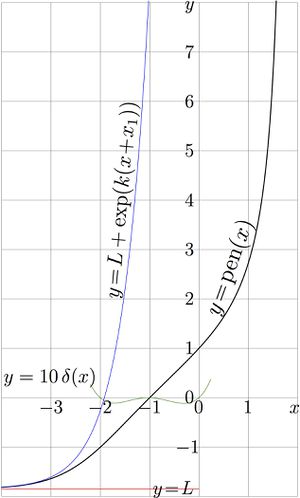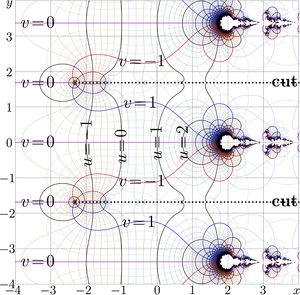Pentation
Pentation is specific superfunction of tetration, constructed with regular iteration at its lowest real fixed point.
if the base of tetration is \(\mathrm e=\exp(1)\approx 2.71\), then the tetration is called natural tetration and the corresponding pentation is called Natural pentation.
Penetration is Fifth of the Ackermann function. Pentation is denoted with symbol pen;
\(\mathrm{pen}_b(z)=A_{b, 5}(z)\)
where \(A_{b,5}\) is Fifth Ackermann function to base \(b\).
As in the case of exponential and tetration, if the base is not indicated in the subscript, it is assumed to be \(\mathrm e\); id est, \(\mathrm{pen}(z)=\mathrm{pen}_\mathrm e(z)\).
The explicit plot and the complex map of the natural pentation are shown in figures at right.
General properties
Pentation satisfies the transfer equation
\(\mathrm{pen}_b(z\!+\!1) = \mathrm{tet}_b\Big( \mathrm{pen}_b(z)\Big)\)
where \(\mathrm{tet}_b\) is tetration to base \(b\). The additional condition, common for all ackermann functions is assumed,
\(\mathrm{pen}_b(0)=1\)
Pentation is holomorphic at least in the part of the complex plane, while the real part of the argument does not exceed some constant. For \(b\!=\!\mathrm e\), this constant is about \(-2.5\)
The range of holomorphism of pentation includes alto the real axis.
For the real base \(b\), larger that unity, pentation is real–holomorphic,
\(\mathrm{pen}_b(z^*)=\mathrm{pen}_b(z)^*\)
Pentation has the exponential asymptotic at large negative values of the real part of the argument,
\(\mathrm{pen}_b(z) = L + \varepsilon + O(\varepsilon^2)\)
where \(L\) is fixed point of tetration, it is solution of equation \(L=\mathrm {tet}_b(L)\)
\(\varepsilon=\exp(k (z-X))\),
parameters \(k\) and \(X\) depend on the base \(b\). For base \(b\!>\!1\), the increment \(k\) is positive. This increment is determined by the derivative of tetration at its lowest real fixed point, and in this case, pentation is periodic function; the period \(P=2 \pi \mathrm i /k\).
Properties of the natural pentation
The base \(b\) of pentation is indicated as subscript, but it it is e, the subsctipt can be omitted, as in the case of tetration, arctetration, exponential and logarithm.
Natural pentation has the following properties:
the limiting value at minus infinity is fuxed point of the natural tetration, \(L_{\mathrm e, 4,0} \!\approx\! -1.8503545290271812\)
Incement at negative valies of real part is \(k\approx 1.86573322821\)
Period \(P=2\pi \mathrm i /k \approx 3.36767615657879\, \mathrm i\)
The period is pure imaginary, so, the map reproduces at the translations along the imaginary axis. A little bit more than two periods are covered by the range of the complex map at right.
Natural pentation has the countable set of logarithmic singularities. The cut lines divide the right hand side of the complex plane to the "independent" strips of width \(P\). There is no way to direct these cut lines to the left, because more singularities are located at each of them.
Along the real axis, at minus infinity, the function pen grows exponentially from its asymptotic value \(L_0\approx -1.8503545290271812\)
The fraphic passes through points with icoordinates \((-3,-1)\), \((-1,0)\), \((0,1)\), \((1,\mathrm e)\).
At larger positive values of the argument, pentation shows very fast growth, much daster than that superfactorial or that of natural tetration.
Visually, \(\mathrm{pen}(2)\) looks as infinity, and, perhaps, \(\mathrm{pen}(3)\) can be considered a "numerical approximation" of the fake Mizugadro number. As tetration has singularity and the branch point at \(-2\), this singularity determines the set of singularities in vicinity of the real axis. The pair of these singularities are seen at points with coordinates approximately \((3.1,\pm 3.1)\); the zooming of the map allows to see them in details.
References
http://article.sciencepublishinggroup.com/pdf/10.11648.j.acm.20140306.14.pdf
http://mizugadro.mydns.jp/PAPERS/2014acker.pdf
D.Kouznetsov. Evaluation of holomorphic ackermanns. Applied and Computational Mathematics. Vol. 3, No. 6, 2014, pp. 307-314.
http://www.ams.org/mcom/2009-78-267/S0025-5718-09-02188-7/home.html
http://www.ils.uec.ac.jp/~dima/PAPERS/2009analuxpRepri.pdf D.Kouznetsov. Analytic solution of F(z+1)=exp(F(z)) in complex z-plane. Mathematics of Computation, v.78 (2009), 1647-1670.
http://www.ils.uec.ac.jp/~dima/PAPERS/2010vladie.pdf D.Kouznetsov. Superexponential as special function. Vladikavkaz Mathematical Journal, 2010, v.12, issue 2, p.31-45.
https://www.morebooks.de/store/ru/book/Суперфункции/isbn/978-3-659-56202-0
http://mizugadro.mydns.jp/BOOK/202.pdf
D.Kouznetsov. Superfunctions (in Russian): Д.Кузнецов. Суперфункции. Lambert Academic Publishing, 2014.
http://math.eretrandre.org/tetrationforum/showthread.php?tid=949 Pentation
Keywords
Ackermann function, Superfunction, Tetration, Transfer equation

